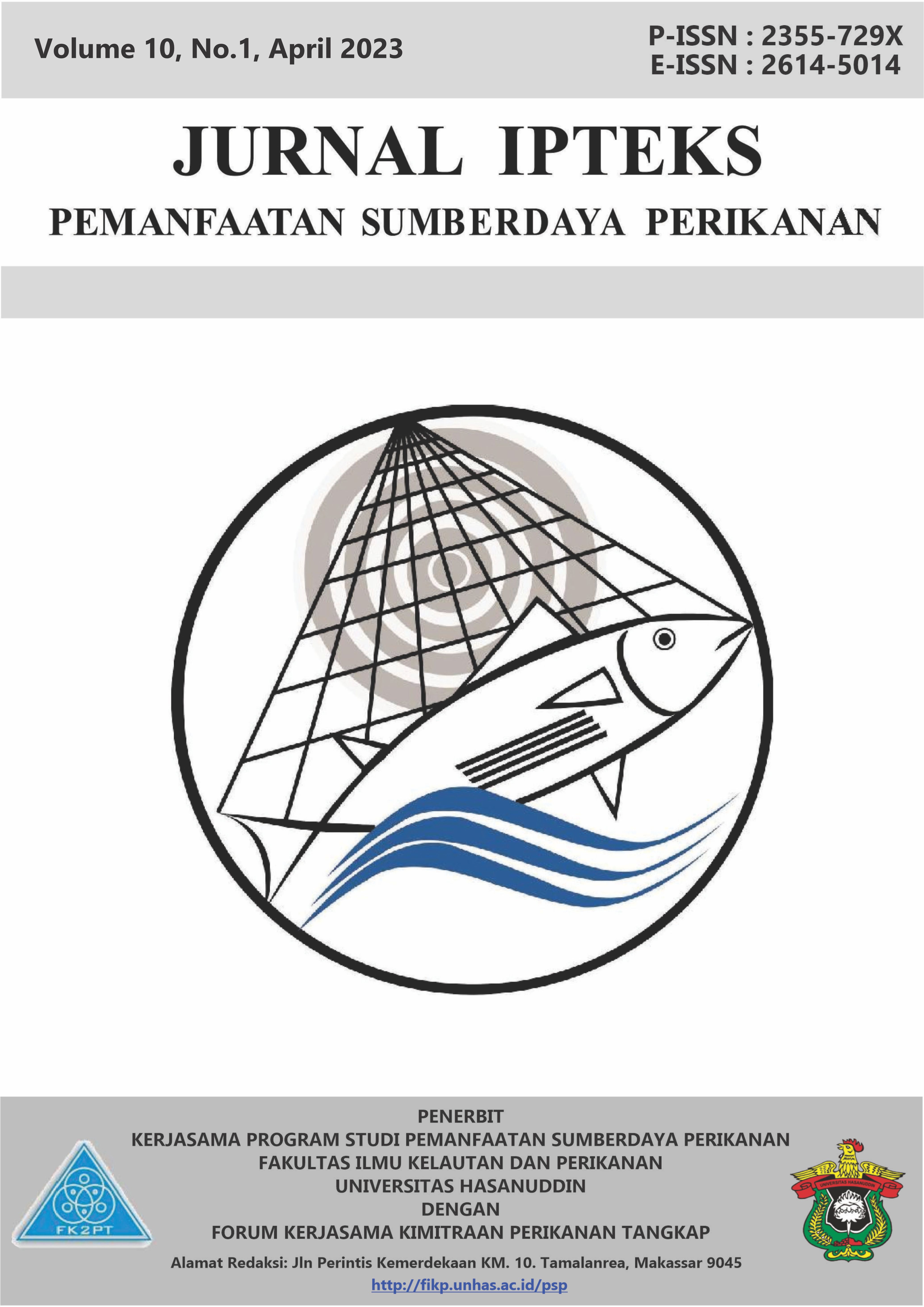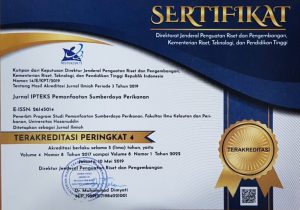The Influence of Ocean Current Patterns on Surface Marine Debris Distribution In Makassar City Waters
DOI:
https://doi.org/10.20956/jipsp.v10i1.26391Keywords:
Marine debris, macro debris, meso-debris, floating, pollution, MakassarAbstract
A survey of the abundance and distribution of macro debris (>2.5 - <100 cm) and meso-debris (>0.5 – <2.5 cm) has been carried out in Makassar City waters. This research was carried out to map the distribution of surface marine debris following ocean current patterns. The macro debris abundance range is 2222-17222 items/km2 and the meso-debris range is 2222-30556 items/km2, with the dominance of 47,03% plastic debris for macro sizes and 49,74% wood debris for meso-sizes. The highest abundance was found at the Jeneberang estuary, then at the Losari Coastal Waters and the lowest at the mouth of the Tallo River. The current pattern in Makassar City waters at low or high tide tends to move from north to south towards the Jeneberang River estuary, with the current speed getting southern and slower. This condition causes a high abundance of macro and meso debris at the mouth of the Jeneberang River.Downloads
References
Agamuthu, P., Mehran, S. B., Norkhairah, A., Norkhairiyah, A. 2019. Marine debris: A review of impacts and global initiatives. Waste management & research : the journal of the International Solid Wastes and Public Cleansing Association, ISWA, 37(10), 987–1002. https://doi.org/10.1177/0734242X19845041
Allsopp M., Walters A., Santillo D., Johnston P. (2006) Plastic Debris in the World's Oceans. Greenpeace Netherlands.
Asmal M, Shinta W, Sulaiman G, Wasir S, Lanuru M. 2021. Identification of floating marine debris based on sea surface current pattern in Barrangcaddi Island, Makassar City. Prosiding Simposium Nasional VIII Kelautan dan Perikanan Fakultas Ilmu Kelautan dan Perikanan, Universitas Hasanuddin. p 295-304
Barboza L G A, Cózar A, Gimenez B C G, Barros T L, Kershaw P J, Guilhermino L. 2019 Macroplastics Pollution in the Marine Environment, in: World Seas: An Environmental Evaluation. Elsevier, pp. 305–328
Chassignet EP, Xu X and Zavala-Romero O, 2021. Tracking Marine Litter With a Global Ocean Model: Where Does It Go? Where Does It Come From? . Front. Mar. Sci. 8:667591. doi: 10.3389/fmars.2021.66759
Cheshire A., and Adler E., 2009. UNEP/IOC Guidelines on Survey and Monitoring of Marine Litter. United Nations Environment Program. UNEP. Intergovernmental Oceanographic Commission, IOC.
Fadlin F., Marfai M.A., Kurniawan A. 2016. Potensi Wisata dan Preferensi Visual Langskap Wisatawan Untuk Pengembangan Pariwisata Pesisir (Kasus: Pantai Angin Mamiri dan Tanjung Bayang Kota Makassar). Majalah Geografi Indonesia 30(1) 19-28.
Fahmi M.C. 2015. Pengelolahan Daerah Aliran Sungai Jeneberang Kota Mkassar Sulawesi Selatan. Geografi Regional Indonesia. DOI: 0606071645
Faizal, A., Werorilangi, S., Samad, W., Lanuru, M., Dalimunte, W. S., Yahya, A. 2021. Abundance and spatial distribution of marine debris on the beach of Takalar Regency, South Sulawesi. IOP Conference Series: Earth and Environmental Science, 763(1), 012060. doi:10.1088/1755-1315/763/1/012060
Fendall L.S., Sewell M.A. 2009. Contributing to marine pollution by washing your face: Microplastics in facial cleansers. Marine Pollution Bulletin 58(8):1225-1228.
Galgani F., Hanke G., Maes T. 2015a. Chapter 2 Global Distribution, Composition and Abundance of Marine Litter. Marine Antropogenic Litter 1:29. DOI: DOI 10.1007/978-3-319-16510-3_2.
Galgani F., Hanke G., Maes T. 2015b. Global Distribution, Composition and Abundance of Marine Litter. Marine Anthropogenic Litter 2:29. DOI: 10.1007/978-3-319-16510-3_2.
GESAMP, 2019. Guidelines for the monitoring and assessment of plastic litter and microplastics in the ocean (Kershaw P J, Turra A amd Galgani F editors). (IMO/FAO/UNESCOIOC/UNIDO/WMO/IAEA/UN/UNEP/UNDP/ISA Joint Group of Experts on the Scientific Aspects of Marine Environmental Protection) Rep. Stud. GESAMP, No. 99.Henry, B., Laitala, K., and Grimstad, I. 2019. Science of the Total Environment Micro fi bres from apparel and home textiles : Prospects for including microplastics in environmental sustainability assessment. Science of the Total Environment. 652 483–494
Gregory M. R. 2009. Environmental implications of plastic debris in marine settings--entanglement, ingestion, smothering, hangers-on, hitch-hiking and alien invasions. Philosophical transactions of the Royal Society of London. Series B, Biological sciences, 364(1526), 2013–2025. https://doi.org/10.1098/rstb.2008.0265
Hays, G. C. 2017. Ocean currents and marine life. Current Biology, 27(11), R470-R473. doi:https://doi.org/10.1016/j.cub.2017.01.044
Isman. F.M,. 2016. Identifikasi Sampah Laut di Kawasan Wisata Pantai Kota Makassar. Skripsi. Fakultas Ilmu Kelautan dan Perikanan. Unhas. Makassar
Jambeck J.R., Geyer R., Wilcox C., Siegler T.R., Perryman M., Anthony Andrady, Narayan R., Law K.L. 2015. Plastic waste Inputs from land Into The Ocean. American Association For The Advencement Of Science. 437:768-771. DOI: DOI: 10.1126/science.1260352
Jaya A.M. 2012. Kajian Kondisi Lingkungan Dan Perubahan Sosial Ekonomi Reklamasi Pantai Losari Dan Tanjung. Tesis. Program Pasca Satajana Universitas Hasanuddin.
Lee, J., Lee, J., Hong, S., Hong, S. H., Shim, W. J., Eo, S. 2017. Characteristics of meso-sized plastic marine debris on 20 beaches in Korea. Marine pollution bulletin, 123(1-2), 92–96. https://doi.org/10.1016/j.marpolbul.2017.09.020
Lippiatt S., Opfer S., Arthur C. 2013. Marine Debris Monitoring and Assessment Recommendations for Monitoring Debris Trends in the Marine Environment, in: N. M. D. P. N. O. a. A. Administration (Ed.), NOAA Technical Memorandum NOS-OR&R-46National Oceanic and Atmospheric Administration Marine Debris Program, 2016).
National Oceanic and Atmospheric Administration Marine Debris Program (NOAA). 2016. Report on Marine Debris Impacts on Coastal and Benthic Habitats. Silver Spring, MD: National Oceanic and Atmospheric Administration Marine Debris Program.
Opfer S., Arthur C., Lippiatt S. 2012. NOAA Marine Debris Shoreline Survey Field Guide, National Oceanic and Atmospheric Administration and I.M. Systems Group, Inc., USA.
Rafsanjani, Shinta. W., Wasir .S., Amran. S., Faizal. A., 2021. Identifikasi Sampah Laut Terapung (Floating Marine Debris) Berdasarkan Pola Musim di Perairan Pulau Barranglompo, Kota Makassar. Prosiding Simposium Nasional VIII Kelautan dan Perikanan Fakultas Ilmu Kelautan dan Perikanan, Universitas Hasanuddin. P 285-294
Richards Z. T., Beger M., 2011. A quantification of the standing stock of macro-debris in Majuro lagoon and its effect on hard coral communities. Marine Pollution Bulletin, 62(8), 1693-1701
Samurović K, 2021. How Ocean Currents Move Pollution Around the World. Geographyrealm ; https://www.geographyrealm.com/author/katarina-samurovic/
Sebille E.v., Wilco C., Lebreton L., Maximenko N., Hardesty B.D., Franeker J.v., Eriksen M., Siegel D., Galgani F., Lavender K. 2015. A global inventory of small floating plastic debris. Environ Res. Lett 10. DOI: 10.1008/1748-9326/10/12/124006.
Setiawan H. (2013) Akumulasi dan Distribusi Logam Berat pada Vegetasi Mangrove di Perairan Pesisir Sulawesi Selatan. Jurnal Ilmu Kehutanan Vol VII No.1:12.
Syaktia A.D., Bouhroumc R., Hidayatib N.V., Koenawand C.J., Boulkamhc A., Sulistyob I., Lebarilliere S., Syafsir Akhlusf P.D., Wong-Wah-Chunge P. 2017. Beach macro-litter monitoring and floating microplastic in a coastal area of Indonesia. Marine Pollution Bulletin 112:10. DOI: 10.1016/j.marpolbul.2017.06.046
Sugianto D.N., ADS A. 2007. Studi Pola Sirkulasi Arus Laut di Perairan Pantai Provinsi Sumatera Barat. Program Studi Oseanografi, Jurusan Ilmu Kelautan FPIK UNDIP Semarang 12 (2):79-92.
U.S. Army Corps of Engineers, 2003. Users Guide To RMA2 WES Version 4.5. US Army, Engineer Research and Development Center Waterways Experiment Station Coastal and Hydraulics Laboratory pp 296
van Cauwenberghe, L., Janssen, C. R. 2014. Microplastics in bivalves cultured for human consumption. Environmental Pollution, 193, 65-70.
van Sebille, E., Aliani, S., Law, K. L., Maximenko, N., Alsina, J. M., Bagaev, A., . . . Wichmann, D. 2020. The physical oceanography of the transport of floating marine debris. Environmental Research Letters, 15(2), 023003. doi:10.1088/1748-9326/ab6d7d)
Willis, K., Denise Hardesty, B., Kriwoken, L., Wilcox, C. 2017. Differentiating littering, urban runoff and marine transport as sources of marine debris in coastal and estuarine environments. Scientific reports, 7, 44479. https://doi.org/10.1038/srep44479
Downloads
Published
Issue
Section
License
Copyright (c) 2023 Jurnal IPTEKS Pemanfaatan Sumberdaya Perikanan

This work is licensed under a Creative Commons Attribution 4.0 International License.










